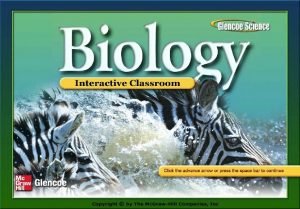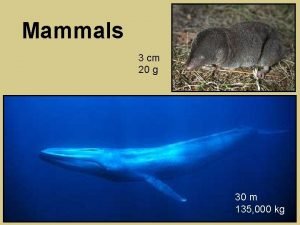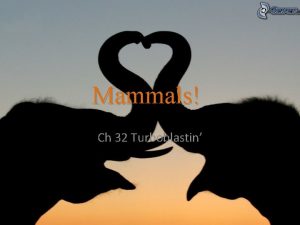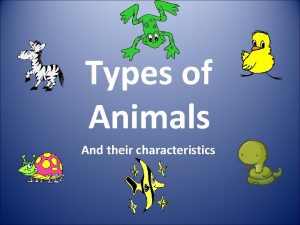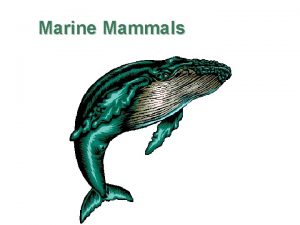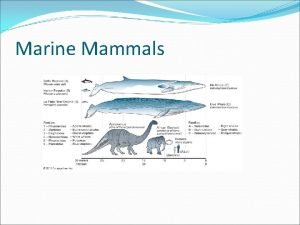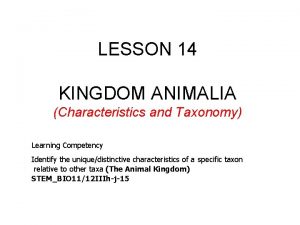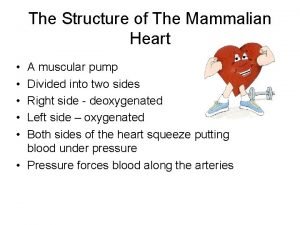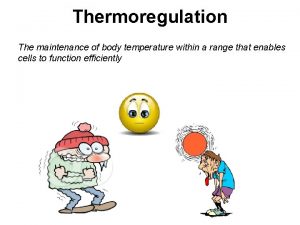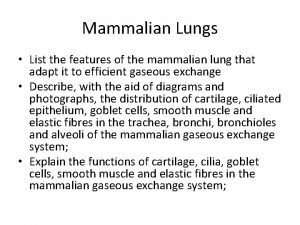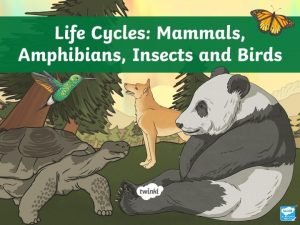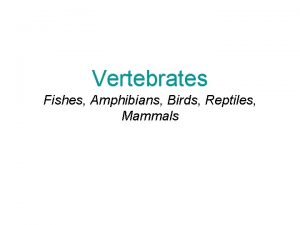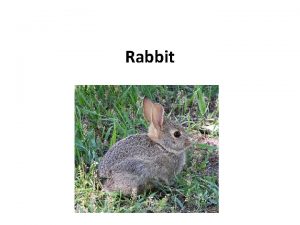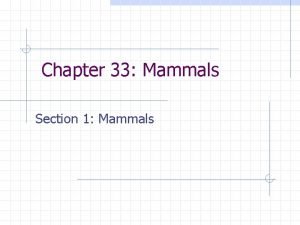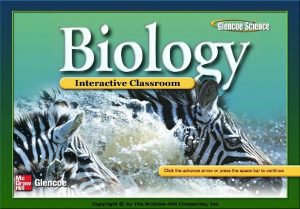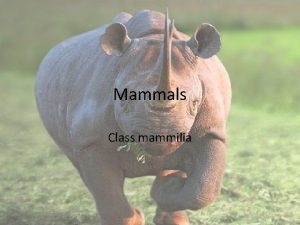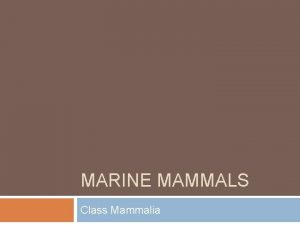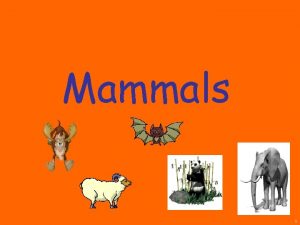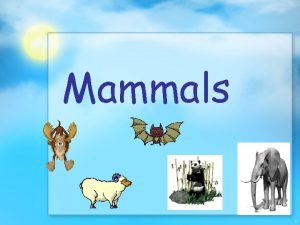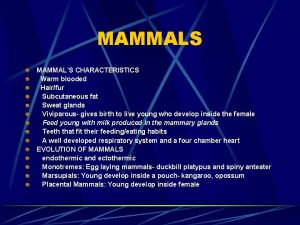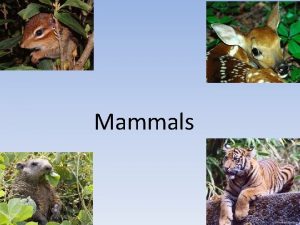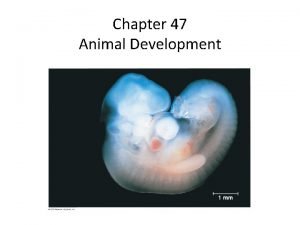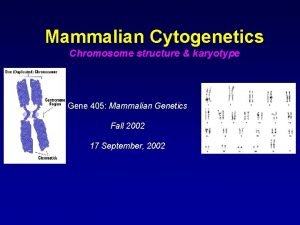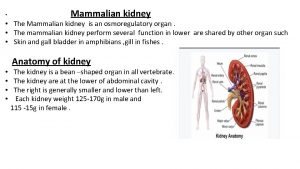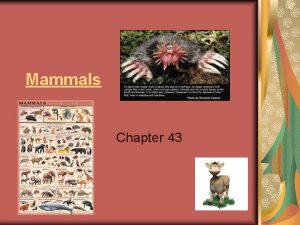Chapter 30 Mammals Section 1 Mammalian Characteristics Section































- Slides: 31


Chapter 30 Mammals Section 1: Mammalian Characteristics Section 2: Diversity of Mammals Click on a lesson name to select.

Chapter 30 Mammals 30. 1 Mammalian Characteristics Hair and Mammary Glands § Two characteristics that distinguish members of class Mammalia from other vertebrate animals are hair and mammary glands.

Chapter 30 Mammals 30. 1 Mammalian Characteristics Functions of Hair 1. Insulation 2. Camouflage 3. Sensory devices 4. Waterproofing 5. Signaling 6. Defense

Chapter 30 Mammals 30. 1 Mammalian Characteristics Other Characteristics § Endothermy § Source of body heat is internal. § Heat is produced by a high metabolic rate. § Body temperature is regulated by internal feedback mechanisms.

Chapter 30 Mammals 30. 1 Mammalian Characteristics Feeding and Digestion § Daily intake of food is used to generate heat to maintain a constant body temperature.

Chapter 30 Mammals 30. 1 Mammalian Characteristics

Chapter 30 Mammals 30. 1 Mammalian Characteristics Trophic Categories 1. Insectivores 2. Herbivores 3. Carnivores 4. Omnivores

Chapter 30 Mammals 30. 1 Mammalian Characteristics Teeth § Reveal the life habits of a mammal § Carnivores use canines to stab and premolars to slice and shear meat. § Incisors of insectivores are long and curved, functioning as pincers in seizing insect prey.

Chapter 30 Mammals 30. 1 Mammalian Characteristics Excretion § Kidneys excrete or retain the proper amount of water in body fluids. § Enables mammals to live in extreme environments Mammals

Chapter 30 Mammals 30. 1 Mammalian Characteristics Respiration § High levels of oxygen are required to maintain a high level of metabolism. § Mammals are the only animals that have a diaphragm.

Chapter 30 Mammals 30. 1 Mammalian Characteristics Circulation § Mammals require a consistent supply of nutrients and oxygen to maintain homeostasis. § Keeping oxygenated and deoxygenated blood separate makes the delivery of nutrients and oxygen more efficient.

Chapter 30 Mammals 30. 1 Mammalian Characteristics The Brain and Senses § Mammals have highly developed brains. § Cerebral cortex is responsible for coordinating conscious activities, memory, and the ability to learn. § Cerebellum is responsible for balance and coordinating movement.

Chapter 30 Mammals 30. 1 Mammalian Characteristics Complex Behavior Senses § The importance of the senses varies from one group of mammals to the next. Glands § A system of glands secretes a variety of fluids that helps to regulate a mammal’s internal environment.

Chapter 30 Mammals 30. 1 Mammalian Characteristics Reproduction § In mammals, the egg is fertilized internally. § Development of the embryo takes place in the female uterus. Movement § Mammals must find food, shelter, and escape from predators.

Chapter 30 Mammals 30. 2 Diversity of Mammals Mammal Classification § Monotremes § Marsupials § Placental mammals

Chapter 30 Mammals 30. 2 Diversity of Mammals Monotremes § Reproduce by laying eggs § Duck-billed platypus

Echidna

Chapter 30 Mammals 30. 2 Diversity of Mammals Marsupials § Very short period of development in the uterus § Crawl into a pouch made of skin and hair and continue development while being nourished by milk from the mother’s mammary glands § Marsupials Kangaroo



Chapter 30 Mammals 30. 2 Diversity of Mammals Placental Mammals § Give birth to young that do not need further development within a pouch Humpback whale








Oh My!!

Chapter 30 Mammals 30. 2 Diversity of Mammals
 Mammals characteristics
Mammals characteristics Mammals and non mammals
Mammals and non mammals Groups of invertebrates animals
Groups of invertebrates animals Chapter 30 section 2 diversity of mammals
Chapter 30 section 2 diversity of mammals Marine mammals characteristics
Marine mammals characteristics Mammal characteristics
Mammal characteristics Characteristics of whales
Characteristics of whales Characteristics of mammals
Characteristics of mammals Marsupils
Marsupils Animals and their characteristics
Animals and their characteristics Characteristics of mammals
Characteristics of mammals Countercurrent exchange
Countercurrent exchange Characteristics of marine mammals
Characteristics of marine mammals Nn small
Nn small Characteristics of mammals
Characteristics of mammals Characteristics of animalia kingdom
Characteristics of animalia kingdom Glycolyaia
Glycolyaia Mammalian heart
Mammalian heart The mammalian excretory system
The mammalian excretory system Dentition in mammal
Dentition in mammal Mammalian excretory system
Mammalian excretory system Mammalian excretory system
Mammalian excretory system Mammalian biomanufacturing
Mammalian biomanufacturing Mammalian excretory system
Mammalian excretory system Cartilage in trachea function
Cartilage in trachea function Body temperature maintenance
Body temperature maintenance Mammalian lung
Mammalian lung 32-1 introduction to mammals answer key
32-1 introduction to mammals answer key Similarities between mammals and amphibians
Similarities between mammals and amphibians Digestion in fish
Digestion in fish Rabbit are small mammals in the family
Rabbit are small mammals in the family Difference between sexual and asexual reproduction
Difference between sexual and asexual reproduction
